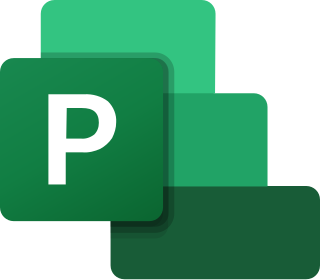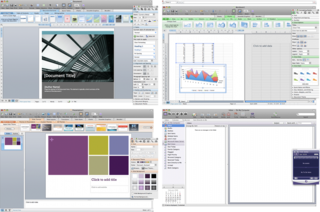
Microsoft Office, or simply Office, is a discontinued family of client software, server software, and services developed by Microsoft. It was first announced by Bill Gates on August 1, 1988, at COMDEX in Las Vegas. Initially a marketing term for an office suite, the first version of Office contained Microsoft Word, Microsoft Excel, and Microsoft PowerPoint. Over the years, Office applications have grown substantially closer with shared features such as a common spell checker, Object Linking and Embedding data integration and Visual Basic for Applications scripting language. Microsoft also positions Office as a development platform for line-of-business software under the Office Business Applications brand.

Microsoft Access is a database management system (DBMS) from Microsoft that combines the relational Access Database Engine (ACE) with a graphical user interface and software-development tools. It is a member of the Microsoft 365 suite of applications, included in the Professional and higher editions or sold separately.
Visual Basic for Applications (VBA) is an implementation of Microsoft's event-driven programming language Visual Basic 6.0 built into most desktop Microsoft Office applications. Although based on pre-.NET Visual Basic, which is no longer supported or updated by Microsoft, the VBA implementation in Office continues to be updated to support new Office features. VBA is used for professional and end-user development due to its perceived ease-of-use, Office's vast installed userbase, and extensive legacy in business.

Windows Messenger is a discontinued instant messaging client included in Windows XP. Designed for use by both corporate and home users, it was originally created, in 2001, as a streamlined and integrated version of MSN Messenger. It was upgraded several times when it was made available for Windows 2000 and Windows Server 2003. Since then, its development stopped. It was superseded by Windows Live Messenger and Microsoft Lync.

Microsoft Outlook is a personal information manager software system from Microsoft, available as a part of the Microsoft 365 software suites. Though primarily being popular as an email client for businesses, Outlook also includes functions such as calendaring, task managing, contact managing, note-taking, journal logging and web browsing.
Microsoft Exchange Server is a mail server and calendaring server developed by Microsoft. It runs exclusively on Windows Server operating systems.

Microsoft Entourage is a discontinued e-mail client and personal information manager that was developed by Microsoft for Mac OS 8.5 and later. Microsoft first released Entourage in October 2000 as part of the Microsoft Office 2001 office suite; Office 98, the previous version of Microsoft Office for the classic Mac OS included Outlook Express 5. The last version was Entourage: Mac 2008, part of Microsoft Office 2008 for Mac, released on January 15, 2008. Entourage was replaced by Outlook for Macintosh in Microsoft Office for Mac 2011, released on October 26, 2010.

Microsoft Project is a project management software product, developed and sold by Microsoft. It is designed to assist a project manager in developing a schedule, assigning resources to tasks, tracking progress, managing the budget, and analyzing workloads.
In computing, a Personal Storage Table (.pst) is an open proprietary file format used to store copies of messages, calendar events, and other items within Microsoft software such as Microsoft Exchange Client, Windows Messaging, and Microsoft Outlook. The open format is controlled by Microsoft who provide free specifications and free irrevocable technology licensing.

Microsoft Office 2003 is an office suite developed and distributed by Microsoft for its Windows operating system. Office 2003 was released to manufacturing on August 19, 2003, and was later released to retail on October 21, 2003, exactly two years after the release of Windows XP. It was the successor to Office XP and the predecessor to Office 2007. The Mac OS X equivalent, Microsoft Office 2004 for Mac was released on May 11, 2004.

Skype for Business Server is real-time communications server software that provides the infrastructure for enterprise instant messaging, presence, VoIP, ad hoc and structured conferences and PSTN connectivity through a third-party gateway or SIP trunk. These features are available within an organization, between organizations and with external users on the public internet or standard phones.

Skype for Business is an enterprise software application for instant messaging and videotelephony developed by Microsoft as part of the Microsoft Office suite. It is designed for use with the on-premises Skype for Business Server software, and a software as a service version offered as part of Microsoft 365. It supports text, audio, and video chat, and integrates with Microsoft Office components such as Exchange and SharePoint.

Microsoft Office 2008 for Mac is a version of the Microsoft Office productivity suite for Mac OS X. It supersedes Office 2004 for Mac and is the Mac OS X equivalent of Office 2007. Office 2008 was developed by Microsoft's Macintosh Business Unit and released on January 15, 2008. Office 2008 was followed by Microsoft Office for Mac 2011 released on October 26, 2010, requiring a Mac with an Intel processor and Mac OS version 10.5 or better. Office 2008 is also the last version to feature Entourage, which was replaced by Outlook in Office 2011. Microsoft stopped supporting Office 2008 on April 9, 2013.

MSN Messenger, later rebranded as Windows Live Messenger, was a cross-platform instant-messaging client developed by Microsoft. It connected to the Microsoft Messenger service and, in later versions, was compatible with Yahoo! Messenger and Facebook Messenger. Versions were developed for Windows, Xbox 360, Mac OS X, BlackBerry OS, iOS, Java ME, S60 on Symbian OS 9.x, MSN TV, Zune HD, Windows Phone, Windows Mobile and Windows CE.

Microsoft Office 2013 is a version of Microsoft Office, a productivity suite for Microsoft Windows. It is the successor to Microsoft Office 2010 and the predecessor to Microsoft Office 2016. Unlike with Office 2010, no OS X equivalent was released.

Microsoft Office 2016 is a version of the Microsoft Office productivity suite, succeeding both Office 2013 and Office for Mac 2011 and preceding Office 2019, which in turn was succeeded by Office 2021 for both platforms. It was released on macOS on July 9, 2015, and on Microsoft Windows on September 22, 2015, for Office 365 subscribers. Mainstream support ended on October 13, 2020, and extended support for most editions of Office 2016 will end on October 14, 2025, the same day as Windows 10. The perpetually licensed version on macOS and Windows was released on September 22, 2015. Office 2016 requires Windows 7 SP1, Windows Server 2008 R2 SP1 or OS X Yosemite at the minimum. It is the last version of Microsoft Office to support Windows 7 SP1, Windows Server 2008 R2 SP1, Windows 8, Windows Server 2012, Windows 8.1, Windows Server 2012 R2, Windows 10 RTM–1803 and Windows Server 2016; as the following version, Microsoft Office 2019 only supports Windows 10 version 1809, Windows Server 2019 or later.
The first release of Microsoft Exchange Server was version 4.0 in April 1996, when it was sold as an upgrade to Microsoft Mail 3.5. Before that, Microsoft Mail v2.0 was replaced in 1991 by "Microsoft Mail for PC Networks v2.1", based on Network Courier from its acquisition of Consumers Software. Exchange Server was an entirely new X.400-based client–server mail system with a single database store that also supported X.500 directory services. During its development, Microsoft migrated their own internal email from a XENIX-based system to Exchange Server from April 1993, with all 32,000 Microsoft mailboxes on Exchange by late 1996. The directory used by Exchange Server eventually became Microsoft's Active Directory service, an LDAP-compliant directory service. Active Directory was integrated into Windows 2000 as the foundation of Windows Server domains.

Microsoft Office 2019 is a version of Microsoft Office for both Windows and Mac. It replaces Office 2016 and was replaced by Office 2021 on October 5, 2021. It was unveiled on April 27, 2018 for Windows 10 and June 12, 2018 for macOS, and launched on September 24, 2018. Some features that had previously been restricted to Office 365 subscribers are available in this release. Office 2019 remain same major version 16 as predecessor Office 2016, therefore it is second perpetual release of Office 16. Microsoft plans to end mainstream support for Office 2019 on October 10, 2023. Unlike other versions of Microsoft Office, Office 2019 will only get two years of extended support, which means that support for Office 2019 will end on the same day as support for Office 2016 and Windows 10, on October 14, 2025.

Microsoft 365 is a product family of productivity software, collaboration and cloud-based services owned by Microsoft. It encompasses online services such as Outlook.com, OneDrive, Microsoft Teams, programs formerly marketed under the name Microsoft Office, enterprise products and services associated with these products such as Exchange Server, SharePoint, and Yammer. It also covers subscription plans encompassing these products, including those that include subscription-based licenses to desktop and mobile software, and hosted email and intranet services.












